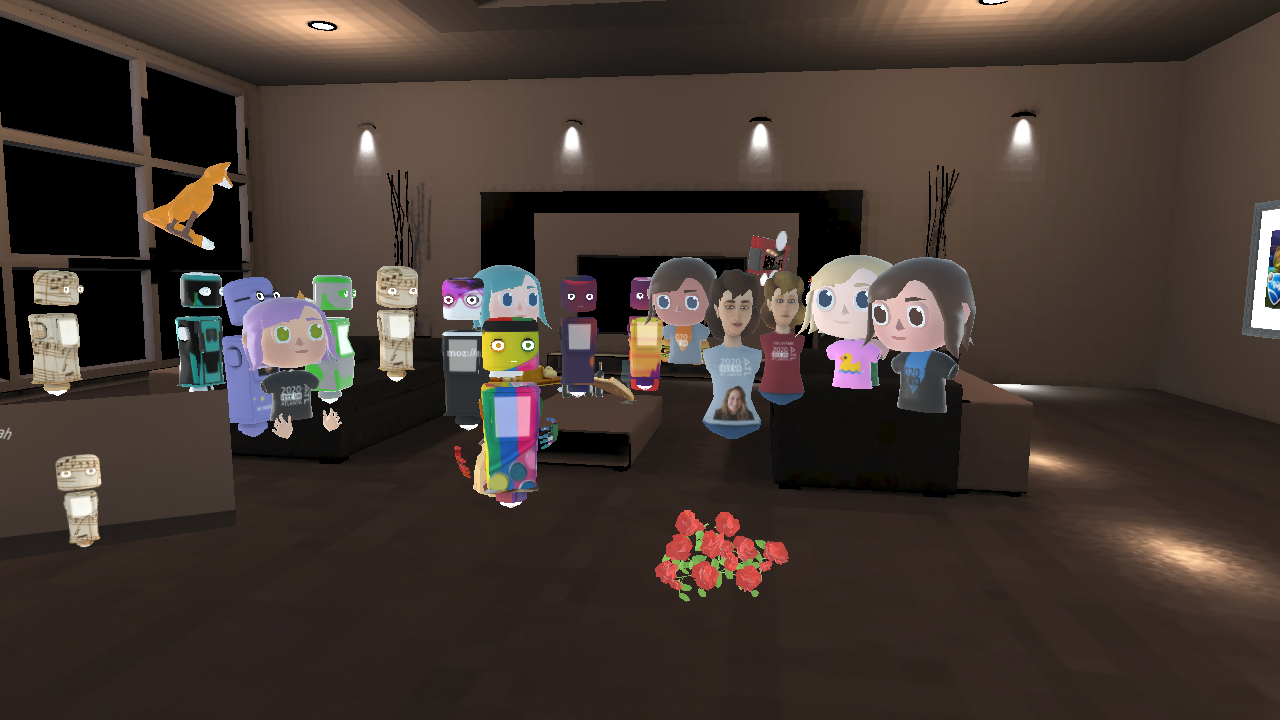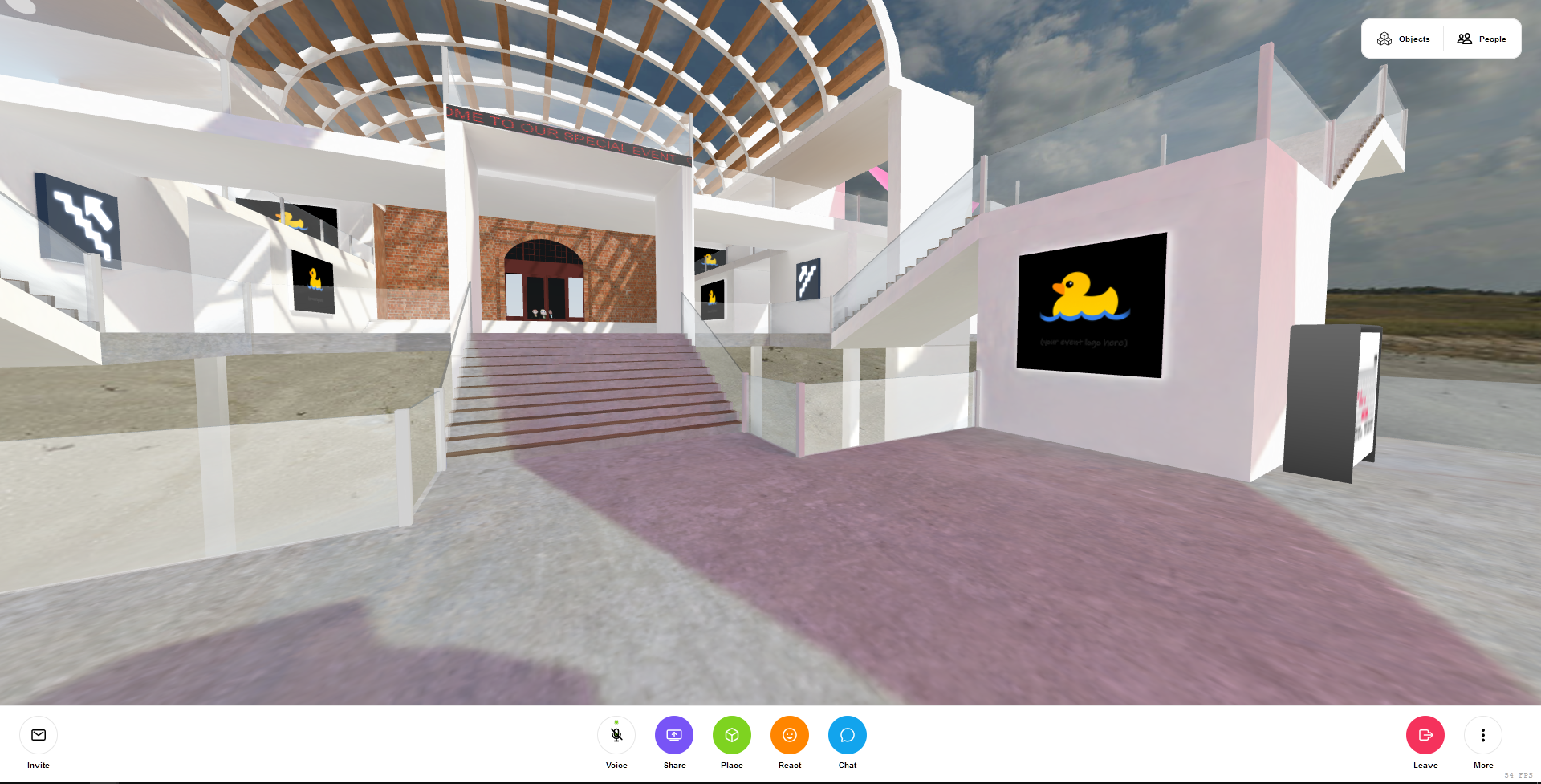Hello, Hubs Creator Community!
Today, I’m going to share a bit about what we’ve been considering and observing around virtual events in Hubs, and some thoughts on where spatial technology in events might be headed more generally. Some of what I’ll cover today is more near-term, and (if you’re still up for it towards the end) you’ll have to forgive the parts where I get more theoretical.
Benefits of Virtual Events
At the start of 2020, IEEE VR moved fully online, with portions of their events in Hubs. This was one of the first conferences to “go digital” in the face of the COVID-19 pandemic. At IEEE VR, people showed up digitally as avatars to watch talks, and were able to fly in the virtual world to get a better view. On the surface, that may seem like a relatively silly benefit of a virtual event, but the implications go a lot further. Virtual events, in many ways, allow us to break the rules set in place by physics; we get to introduce superpowers.
One key practical benefit of virtual events is that they allow us to meet with the people we care about regardless of where everyone is in the world. For some types of conferences and events, this may not be entirely desirable - for example, if you have an event with hardware demos, it can be challenging to replicate that in a digital format with today’s limited (but growing) haptic device technology. But for others, immersive virtual worlds can provide a playful, open environment for communities to co-create and collaborate in new, more engaging ways.
Another benefit of virtual events is that we can increase the protections and degree of control over how much data we share about ourselves. At a typical conference, you look pretty much the same as everyone else - you each have a name tag that shows your name and professional affiliation that others can see. You probably aren’t changing clothes from session to session, and as a result, you don’t actually have that much control over how other people perceive you. With virtual events, though, platforms can give individuals far more granularity over how much detail they’re choosing to share about themselves.

Today, for an event hosted in Hubs, that means that you can change your appearance at a whim. You can change whether or not your display name shows personal information or not - maybe sometimes choosing a social media handle or screen name in some events, but your full name with other groups. The ability to have more control of releasing personal or identifiable information can protect vulnerable users and enable them to have more agency in participating in events. It’s critical to mention that identity technologies can be sensitive and complex, and as we consider how we might evolve identities in and across Hubs, we’ll be drawing from a wide range of perspectives and expertise. This will be especially important in the coming years as advancements in face tracking, avatar, and augmented reality continue to push the boundaries of our concepts of digital identity.
Presence in Virtual Events
A common critique of virtual events is that you miss out on the "presence" of being face to face, but in reality, new technologies widen the spectrum of what it means to attend an event. We used to have an “engagement” binary - are you there or not? But now we get to play with nuance through different applications and features.
Here’s an example:
Let’s take two people. One is in Austin as a speaker for SXSW. They attend their session, but then they go to see people and don’t go to any other sessions or events except for the one that they present at. Are they more or less “at” SXSW than someone who is meticulously following live blogs the entire day and speaker twitter feeds, taking in a constant stream of information over the course of the conference? With online events, we start to question what it means to “be” an attendee and break down the parts of virtual events with more granularity.
Looking Ahead
When we think about how that applies in the future to VR, we’re going to keep discovering opportunities that right now still feel out of reach to us today. Across the virtual event space, we’re still largely using methods that aim to replicate the way that physical world events have happened. Back in March 2020, there was a big question about whether or not the Game Developer Conference (GDC) was going to be held in person. A lot of people started talking about whether or not an event of that size could be held in VR. For some context, GDC attendance is close to 30,000 people - so you may start to fundamentally ask yourself “do I even really want that in a virtual space?” What are the tradeoffs? What are the benefits?”
When we think about supporting large events to enable meaningful engagements with other people, the size of the event is a secondary factor, not the primary one. When we shift away from the space of the event being the constraint, we can instead focus on new strategies and technologies that more effectively connect people. Personally, I think that’s one of the biggest areas of opportunities in virtual events right now - building systems that help amplify an event's purpose, and empower visitors to create meaningful connections on their own terms.
This is an opportunity for hybrid events as well. We can extend our in-person conferences and artifacts from those events into a spatial environment where we can gather in the future. We can keep asynchronous chat platforms and tools in place so that attendees have a network and community after the event. We can have video streams from a speaker go into a room of avatars, or set up a screen where an avatar presents to an in-person audience, or do both - like what was shown at SIGGRAPH ASIA in 2017.
We can also begin to think about the time span of events differently. What would it look like to have a conference that has a virtual space hosted for years, and over this time, the community was collecting and indexing artifacts in a navigable, 3D space that anyone could onboard to and explore? Those artifacts could be posters, they could be papers, or they could be perfectly recreated, holographic speakers that have been volumetrically captured in real-time or from the past, explaining the poster to you, and adding additional context over the years. These “events” could be amended and expanded over time, and linked spatially to other events, or talks.
Fundamentally, what we’re starting to see - and will see more of as immersive technologies continue to advance - is a blurring between the “time” an event takes place, and the “space” where an event takes place. They used to be completely coupled together, but that doesn’t have to be the case anymore.

The future of events is tied to the future of "virtual events." Making content available online gives access to new audiences and allows people, (regardless of location or circumstance) to engage in brand new ways. With Hubs, one of our goals is to make building virtual worlds as easy to create as a slide deck or a text document. By giving everyone those tools, the spaces we begin to inhabit virtually for events can be collaboratively built, and they can last a lot longer than they’d be able to if they were limited by our physical geography. That’s what excites me so much about the Creator Labs and the Hubs community - this is, really, the right audience to really be pushing that mission forward and showing the world how it can be done.
If you’ve used Hubs (or considered using Hubs) for an event, we’d love to hear your thoughts on what would improve the experience and what you enjoyed. Let us know by joining us in Discord or on Twitter!
Ready to get started with your own hub? Visit https://hubs.mozilla.com/#subscribe today!




